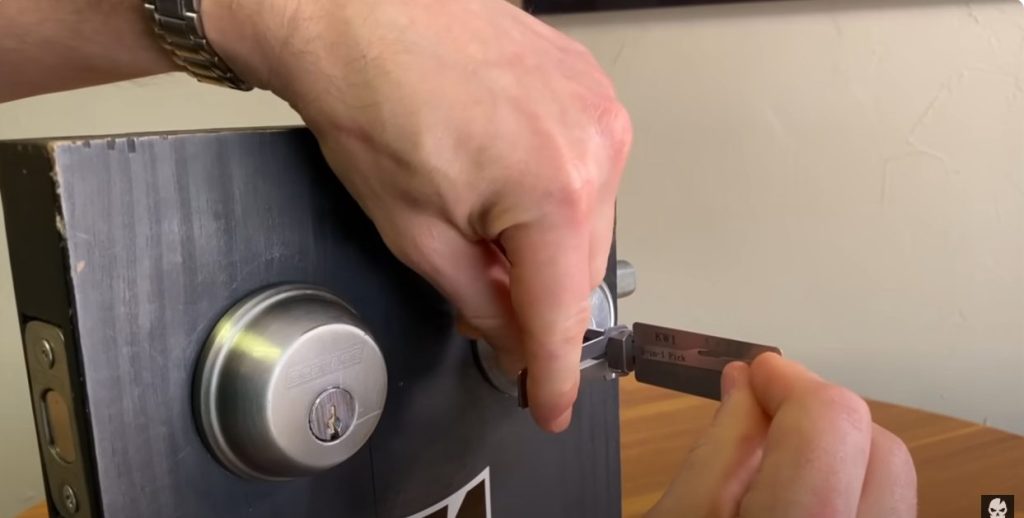
Lishi tools are specialized instruments used to pick and decode locks. Mastering these tools requires practice and patience, particularly for those new to lock picking. Understanding how Lishi tools function is essential for effective use. Each tool is uniquely designed for specific lock types, and knowing which one to select can greatly impact the success of the picking process. Familiarity with the inner workings of locks enhances a user’s ability to navigate them.

Starting to use Lishi tools involves grasping fundamental techniques, such as inserting the tool correctly and applying the right amount of tension. Feeling for the pins within the lock is a critical skill that develops with practice. As users advance, they can learn various picking techniques and maintenance tips, allowing them to benefit from increased efficiency and accuracy in their lock picking efforts. Whether for personal use or professional locksmithing, mastering Lishi tools offers significant advantages.
Overview of Lishi Tools
Origin and Evolution of Lishi Tools
Lishi tools originated in China during the 1980s, created by a locksmith named Li Jianming. He sought to improve lock picking methods and designed a tool that could both pick and decode locks. This innovative approach led to the creation of the Lishi tool, which gained significant popularity among locksmiths globally.
Over the years, Lishi tools have experienced numerous enhancements. They are now recognized as advanced locksmith tools, favored by professionals for their versatility. These tools are widely used to tackle a variety of locks, including those found in vehicles.
Variety of Lishi Tools
Lishi tools come in various forms, each tailored for specific lock types. Some commonly used types include:
- 2-in-1 Tools: These tools are engineered to both pick and decode, making them versatile choices for locksmiths. They can handle many lock varieties, which is why they are a staple in many toolkits.
- 3-in-1 Tools: Building on the 2-in-1 design, these include a tension wrench, enhancing their utility. They’re particularly adept at working with wafer locks, making them essential for automotive locksmithing.
- Direct-Read Tools: These specialized tools allow locksmiths to decode locks without the need for picking. They are ideal for situations that require quick access without causing damage to the lock, catering to those who prioritize efficiency and care.
Lishi tools represent a significant advancement in locksmithing technology, allowing professionals to address complex lock challenges effectively. With their range of options, locksmiths can equip themselves with the necessary tools for various lock-related tasks.
Getting Started with Lishi Tools
Choosing the Right Lishi Tool
When beginning to work with Lishi tools, selecting the appropriate one for the specific lock is vital. Each tool corresponds to different vehicle brands and lock types. Therefore, knowing which tool matches the car’s make and model is essential for effective use.
To simplify this process, users can utilize the Lishi Tool Selector. This resource assists in identifying the correct tool needed for the task at hand. It is important to remember that using an incorrect tool can lead to lock damage and complicate the picking process.
Reviewing the Lishi Tools User Manual
The Lishi Tools User Manual serves as a detailed guide for both novices and seasoned locksmiths. It includes everything from tool selection to lock picking techniques. By consulting the manual, users can better understand how to operate the tools effectively.
This user manual can be downloaded for free online, making it accessible for anyone interested in mastering Lishi tools. Thoroughly reading the manual ensures users are aware of best practices and can apply techniques accurately.
In summary, taking the time to choose the right Lishi tool and review the user manual can significantly enhance the user’s skills and efficiency in the field. Understanding these components lays a strong foundation for working with Lishi tools successfully.
The Picking Process
Order and Technique for Picking
Picking locks with Lishi tools requires a clear order and skillful technique. First, it is important to select the right Lishi tool based on the specific lock being worked on. Knowing the correct tool can greatly enhance the chances of success. Once the tool is ready, it is inserted into the keyway carefully. A tension wrench is then used to apply a gentle turning force on the lock.
Next, the user feels for the binding pin. This pin is the one that needs lifting to set the lock. By applying upward pressure, the user listens for a subtle click, indicating the pin is set in place. This method should be repeated for each binding pin until all are in the correct position, allowing the lock to open.
The procedure may differ slightly based on the type of lock and the Lishi tool in use. Therefore, referring to the Lishi user manual is recommended for specifics about various tools. Practicing this technique is crucial to prevent damage to either the lock or the tool being used.
Using Lishi Tools for Decoding
Beyond simply picking locks, Lishi tools also excel in decoding. Decoding is the process where the user reads the internal code of the lock to create a duplicate key. To start decoding, the tool is inserted into the lock while still using slight tension from a tension wrench.
As the user feels for the individual pins, they assess their positions carefully. Each pin’s height is vital for determining the lock’s internal code. This code can then be used for crafting a matching key. Precise technique and careful handling are essential during this process to protect both the lock and the tool.
Not all Lishi tools have the capability to decode locks, so checking the user manual is crucial for instructions on each specific tool. The skill needed for decoding should not be underestimated; it requires a steady hand and focused mind to identify each pin accurately.
The picking and decoding processes with Lishi tools highlight the importance of understanding keyways, cuts, and tumbler arrangements in locks. Mastering these techniques can significantly enhance one’s ability to work effectively with different lock types, including brands like Kwikset and Master Lock. With practice, proficiency in both picking and decoding can be achieved, unlocking a range of possibilities for locksmithing and security work.
Advanced Lishi Tool Usage
Working with Automotive Locks
The Lishi tool proves highly effective for automotive locks, especially as vehicles adopt more sophisticated smartkey cylinders. These locks often present challenges for locksmiths, but the Lishi tool is designed with these complexities in mind. It is important to select the right Lishi tool that matches the specific make and model of the vehicle being serviced. Using the correct tool enhances the chances of successful picking and decoding.
Key Tips:
- Verify the vehicle’s lock type before starting.
- Practice picking various smartkey cylinders to gain experience.
- Familiarize yourself with manufacturer-specific tools for better outcomes.
Navigating Residential and Commercial Locks
While the Lishi tool is primarily recognized for automotive use, it also adapts well to residential and commercial lock applications. In residential settings, the KW1 and SC1 keyways are common. The Lishi tool simplifies the process of both picking and decoding these locks, making it an essential tool for residential locksmiths.
For commercial locks, versatility remains a strength of the Lishi tool. It can work effectively on different lock cylinders, including Master Lock padlocks. However, using Lishi tools on commercial locks may require additional practice. There is often a learning curve involved, and developing a tactile sense of the tool’s response is crucial.
Important Notes:
- Understand the common keyways used in residential settings.
- Take time to practice with various commercial lock types.
- Build confidence gradually to handle more complex systems.
By mastering these applications, locksmiths can elevate their skills in the industry, providing more efficient service and expanding their expertise with the Lishi tool. This reinforces the tool’s value as an integral part of any locksmith’s toolkit.
Maintenance and Skill Enhancement
Caring for Your Lishi Tools
Proper care of Lishi tools is crucial to maintain their effectiveness and longevity. After each session, it’s wise to clean the tools using a gentle cloth to eliminate any dirt or residue. It’s important to steer clear of strong chemicals and rough materials that might harm the tools.
For storage, keep the tools in a cool, dry area, away from moisture and direct sunlight. Regularly check the tools for any signs of wear, such as scratches or bending. If any tool shows damage, it should be replaced immediately to ensure the best results during lock picking.
Improving Locksmith Skills with Lishi
Lishi tools serve as a vital aid for locksmiths aiming to enhance their abilities and acquire new methods. Enrolling in training courses or workshops centered around Lishi tool applications can be beneficial. These events not only introduce the latest techniques, but also provide chances to connect with fellow locksmiths.
To further develop skills, consistent practice with Lishi tools is essential. Start with locks that are familiar and gradually increase the difficulty level as confidence builds. Engaging with more complicated locks promotes growth and skill refinement.
Additionally, keeping informed about advancements in the locksmith industry is critical. Attending relevant conferences, reading trade magazines, and joining online discussions helps locksmiths stay updated on innovative tools and techniques.
By diligently maintaining Lishi tools and continuously honing their skills, locksmiths can enhance their professionalism and efficiency.
Frequently Asked Questions
What are the steps to effectively use a Lishi 2-in-1 pick and decoder on a lock?
To use a Lishi 2-in-1 pick and decoder, start by choosing the correct tool tailored for the lock type at hand. Insert the tool into the lock, ensuring it fits snugly. Next, apply pressure with the tension wrench. Move the pick back and forth gently until each pin is felt setting into place. Once you confirm that all pins are set, turn the tension wrench to unlock the mechanism.
How do you determine the correct Lishi tool for a specific lock type?
Choosing the right Lishi tool is crucial for effective lock picking. Each tool is crafted for specific lock designs. A user guide from Lishi Tools will provide detailed information on selecting the right tool based on the lock type. Checking this reference is essential to avoid any compatibility issues and to ensure successful operation.
What are the best practices for maintaining the longevity of a Lishi lock pick set?
To prolong the life of a Lishi lock pick set, proper care is necessary. Here are some tips:
- Storage: Keep tools in a cool, dry place to prevent moisture damage.
- Cleaning: After every use, wipe down tools to remove dust and debris.
- Avoid Extremes: Do not expose tools to extreme temperatures or harsh conditions, as these can lead to rust or wear.
By following these simple steps, users can maintain their tools in excellent condition.
Can a Lishi KW1 tool be effectively used on all residential locks?
The Lishi KW1 tool is specifically designed for Kwikset locks. While it may function on a limited number of other residential locks, it is not advisable to use it universally. For optimal results, individuals should use the appropriate Lishi tool for the specific lock being picked.
What are the differences between various Lishi lock pick models?
Lishi offers a variety of lock pick models, each tailored for different locks. Some models specialize in automotive locks, while others are intended for residential use. Additionally, certain models are made for specific brands like Kwikset or Schlage. Thus, selecting the right model for the job is vital to achieve effective results.
How does one decode a lock using a Lishi tool after successful picking?
Once a lock is picked with a Lishi tool, decoding the lock is the next step to find key cuts for a replacement. To do this, insert the Lishi decoder into the lock and rotate it until it stops. This action allows the user to read the depths of the wafers, which reveals the necessary cuts for cutting a new key. Following this process allows for accurate duplication of keys as needed.
Frequently Asked Questions
What is the proper method for utilizing a Lishi lock pick?
To effectively use a Lishi lock pick, the user should start by inserting the tool into the lock while ensuring it is positioned correctly. The pick should be turned gently to feel the pins inside. The user must then apply slight pressure while lifting the pins one by one until they are set at the shear line, allowing the lock to open.
How can someone identify the right Lishi tool for a specific lock?
Choosing the correct Lishi tool involves knowing the lock type and its pin configuration. The user should check the specifications of the lock and match them to the compatible Lishi tool model. Often, each tool is designed for particular lock brands and pin styles.
Can a single Lishi tool model work on locks with varying pin counts?
Typically, a Lishi tool is designed for a specific pin count or lock type. Using one tool on locks with different pin configurations may not yield effective results. It is best to use the model that corresponds directly with the lock’s specifications.
What important rules should be followed when picking locks with a Lishi tool?
When using a Lishi tool, it’s crucial to keep these guidelines in mind:
- Practice legality: Ensure lock picking is legal in your location.
- Gentle pressure: Apply consistent but light pressure to avoid damaging the lock.
- Take your time: Rushing can lead to mistakes.
- Be respectful: Only pick locks that you own or have permission to open.
Are there legal aspects to consider when using lockpicking tools in the US?
In the United States, laws regarding lockpicking tools vary by state. It is essential to check local regulations to determine if owning or using lockpicking tools is permitted. Some states require users to be licensed locksmiths or to have explicit permission from the lock owner.
What distinctions are there between Lishi tools like the SS001 and SS002?
The Lishi SS001 and SS002 tools serve different purposes based on their design and the locks they are intended for. The SS001 is often used for specific lock brands, while the SS002 may be suited for others. The main differences lie in their compatibility with lock pin configurations and overall functionality.

